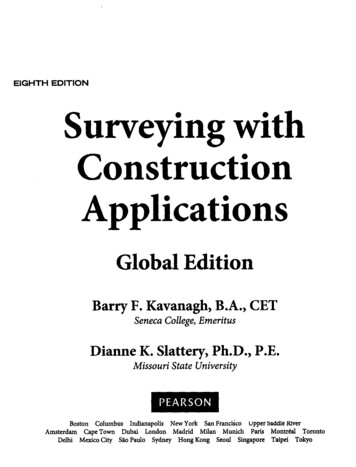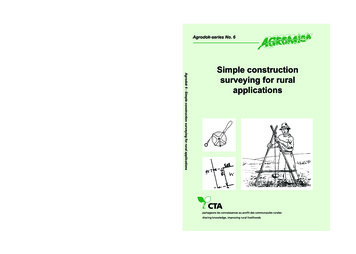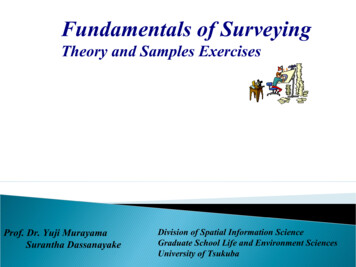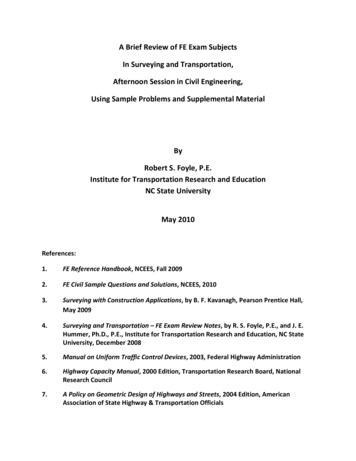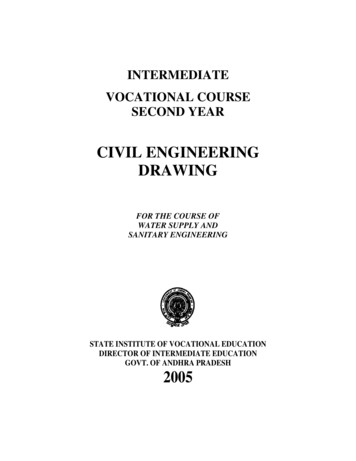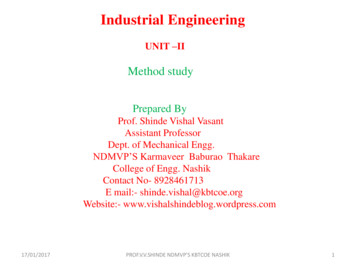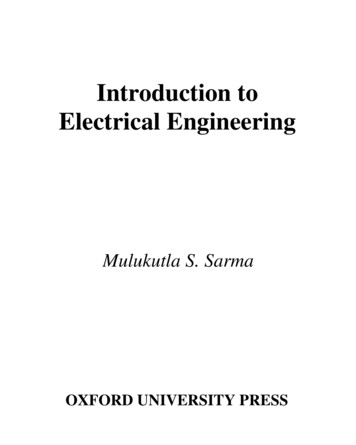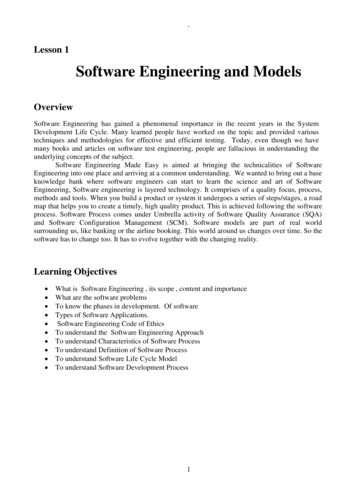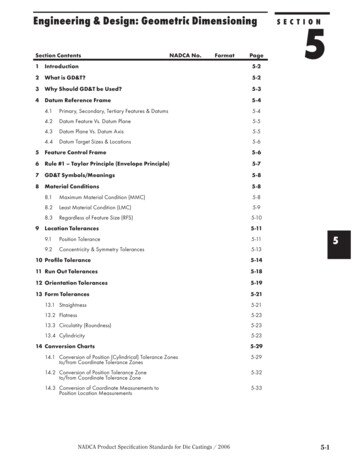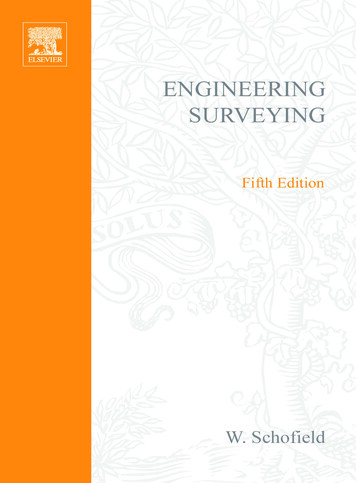
Transcription
Engineering Surveying
This book is dedicated to my late wife Jean and my daughter Zoë
Engineering SurveyingTheory and ExaminationProblems for StudentsFifth EditionW. SchofieldPrincipal Lecturer, Kingston UniversityOXFORDAUCKLANDBOSTON JOHANNESBURGMELBOURNENEW DELHI
Butterworth-HeinemannLinacre House, Jordan Hill, Oxford OX2 8DP225 Wildwood Avenue, Woburn, MA 01801-2041A division of Reed Educational and Professional Publishing LtdA member of the Reed Elsevier plc groupFirst published 1972Second edition 1978Third edition 1984Fourth edition 1993Reprinted 1995, 1997, 1998Fifth edition 2001 W. Schofield 1972, 1978, 1984, 1993, 1998, 2001All rights reserved. No part of this publicationmay be reproduced in any material form (includingphotocopying or storing in any medium by electronicmeans and whether or not transiently or incidentallyto some other use of this publication) without thewritten permission of the copyright holder except inaccordance with the provisions of the Copyright,Designs and Patents Act 1988 or under the terms of alicence issued by the Copyright Licensing Agency Ltd,90 Tottenham Court Road, London, England W1P 9HE.Applications for the copyright holder’s written permissionto reproduce any part of this publication should beaddressed to the publishersBritish Library Cataloguing in Publication DataSchofield, W. (Wilfred)Engineering surveying: theory and examination problems for students. – 5th ed.1 SurveyingI Title526.9′024624Library of Congress Cataloguing in Publication DataSchofield, W. (Wilfred)Engineering surveying: theory and examination problems for students/W. Schofield. – 5th ed.p. cm.ISBN 0 7506 4987 9 (pbk.)1 SurveyingI Title.TA545.S263 2001526.9′024′62–dc21ISBN 0 7506 4987 9Typeset in Replika Press Pvt Ltd. 100% EOU, Delhi 110 040, (India)Printed and bound in Great Britain
ContentsPreface to fifth edition viiPreface to fourth edition ixAcknowledgements xi1 Basic concepts of surveying 1Definition – Basic measurements – Control networks – Locating position – Locatingtopographic detail – Computer systems – DGM – CAD – GIS – Vector/raster – Topology –Laser scanner – Summary – Units of measurement – Significant figures – Rounding offnumbers – Errors in measurement – Indices of precision – Weight – Rejection of outliers –Combination of errors2 Vertical control 43Introduction – Levelling – Definitions – Curvature and refraction – Equipment – Instrumentadjustment – Principle of levelling – Sources of error – Closure tolerances – Errordistribution – Levelling applications – Reciprocal levelling – Precise levelling – Digitallevelling – Trigonometrical levelling – Stadia tacheometry3 Distance 117Tapes – Field work – Distance adjustment – Errors in taping – Accuracies –Electromagnetic distance measurement (EDM) – Measuring principles – Meteorologicalcorrections – Geometrical reductions – Errors and calibration – Other error sources –Instrument specifications – Developments in EDM – Optical distance measurement (ODM)4 Angles 178The theodolite – Instrumental errors – Instrument adjustment – Field procedure – Measuringangles – Sources of error5 Position 208Introduction – Reference ellipsoid – Coordinate systems – Local systems – Computation onthe ellipsoid – Datum transformations – Orthomorphic projection – Ordnance SurveyNational Grid – Practical applications – The Universal Transverse Mercator Projection(UTM) – Plane rectangular coordinates6 Control surveys 252Traversing – Triangulation – Trilateration – Triangulateration – Inertial surveying7 Satellite positioning 307Introduction – GPS segments – GPS receivers – Satellite orbits – Basic principle of positionfixing – Differencing data – GPS field procedures – Error sources – GPS survey planning –Transformation between reference systems – Datums – Other satellite systems –Applications
viContents8 Curves 347Circular curves – Setting out curves – Compound and reverse curves – Short and/or smallradius curves – Transition curves – Setting-out data – Cubic spiral and cubic parabola –Curve transitional throughout – The osculating circle – Vertical curves9 Earthworks 420Areas – Partition of land – Cross-sections – Dip and strike – Volumes – Mass-hauldiagrams10 Setting out (dimensional control) 464Protection and referencing – Basic setting-out procedures using coordinates – Technique forsetting out a direction – Use of grids – Setting out buildings – Controlling verticality – Controllinggrading excavation – Rotating lasers – Laser hazards – Route location – Underground surveying– Gyro-theodolite – Line and level – Responsibility on site – Responsibility of the setting-outengineerIndex517
Preface to the fourth editionThis book was originally intended to combine volumes 1 and 2 of Engineering Surveying, 3rd and2nd editions respectively. However, the technological developments since the last publication date(1984) have been so far-reaching as to warrant the complete rewriting, modernizing and productionof an entirely new book.Foremost among these developments are the modern total stations, including the automatic selfseeking instruments; completely automated, ‘field to finish’ survey systems; digital levels; land/geographic information systems (L/GIS) for the managing of any spatially based information oractivity; inertial survey systems (ISS); and three-dimensional position fixing by satellites (GPS).In order to include all this new material and still limit the size of the book a conscious decisionwas made to delete those topics, namely photogrammetry, hydrography and field astronomy, moreadequately covered by specialist texts.In spite of the very impressive developments which render engineering surveying one of themost technologically advanced subjects, the material is arranged to introduce the reader to elementaryprocedures and instrumentation, giving a clear understanding of the basic concept of measurementas applied to the capture, processing and presentation of spatial data. Chapters 1 and 4 deal with thebasic principles of surveying, vertical control, and linear and angular measurement, in order topermit the student early access to the associated equipment. Chapter 5 deals with coordinatesystems and reference datums necessary for an understanding of satellite position fixing and anappreciation of the various forms in which spatial data can be presented to an L/GIS. Chapter 6deals with control surveys, paying particular attention to GPS, which even in its present incompletestage has had a revolutionary impact on all aspects of surveying. Chapter 7 deals with elementary,least squares data processing and provides an introduction to more advanced texts on this topic.Chapters 8 to 10 cover in detail those areas (curves, earthworks and general setting out on site) ofspecific interest to the engineer and engineering surveyor. Each chapter contains a section of‘Worked Examples’, carefully chosen to clearly illustrate the concepts involved. Student exercises,complete with answers, are supplied for private study. The book is aimed specifically at students ofsurveying, civil, mining and municipal engineering and should also prove valuable for the continuingeducation of professionals in these fields.W. Schofield
This Page Intentionally Left Blank
Preface to the fifth editionSince the publication of the fourth edition of this book, major changes have occurred in thefollowing areas: surveying instrumentation, particularly Robotic Total Stations with Automatic Target Recognition,reflectorless distance measurement, etc., resulting in turnkey packages for machine guidanceand deformation monitoring. In addition there has been the development of a new instrumentand technique known as laser scanning GIS, making it a very prominent and important part of geomatic engineering satellite positioning, with major improvements to the GPS system, the continuance of the GLONASSsystem, and a proposal for a European system called GALILEO national and international co-ordinate systems and datums as a result of the increasing use ofsatellite systems.All these changes have been dealt with in detail, the importance of satellite systems beingevidenced by a new chapter devoted entirely to this topic.In order to include all this new material and still retain a economical size for the book, it wasnecessary but regrettable to delete the chapter on Least Squares Estimation. This decision wasbased on a survey by the publishers that showed this important topic was not included in themajority of engineering courses. It can, however, still be referred to in the fourth edition or inspecialised texts, if required.All the above new material has been fully expounded in the text, while still retaining the manyworked examples which have always been a feature of the book. It is hoped that this new editionwill still be of benefit to all students and practitioners of those branches of engineering whichcontain a study and application of engineering surveying.W. SchofieldFebruary 2001
This Page Intentionally Left Blank
AcknowledgementsThe author wishes to acknowledge and thank all those bodies and individuals who contributed inany way to the formation of this book.For much of the illustrative material thanks are due to Intergraph (UK) Ltd, Leica (UK) Ltd,Trimble (UK) Ltd, Spectra-Precision Ltd, Sokkisha (UK) Ltd, and the Ordnance Survey of GreatBritain (OSGB).I am also indebted to OSGB for their truly excellent papers, particularly ‘A Guide to Co-ordinateSystems in Great Britain’, which formed the basis of much of the information in chapter 7.I must also acknowledge the help received from the many papers, seminars, conferences, andcontinued quality research produced by the IESSG of the University of Nottingham.Finally, may I say thank you to Pat Affleck of the Faculty of Technology, Kingston University,who freely and unstintingly typed all this new material.
This Page Intentionally Left Blank
1Basic concepts of surveyingThe aim of this chapter is to introduce the reader to the basic concepts of surveying. It is thereforethe most important chapter and worthy of careful study and consideration.1.1 DEFINITIONSurveying may be defined as the science of determining the position, in three dimensions, ofnatural and man-made features on or beneath the surface of the Earth. These features may then berepresented in analog form as a contoured map, plan or chart, or in digital form as a threedimensional mathematical model stored in the computer. This latter format is referred to as a digitalground model (DGM).In engineering surveying, either or both of the above formats may be utilized in the planning,design and construction of works, both on the surface and underground. At a later stage, surveyingtechniques are used in the dimensional control or setting out of the designed constructional elementsand also in the monitoring of deformation movements.In the first instance, surveying requires management and decision making in deciding the appropriatemethods and instrumentation required to satisfactorily complete the task to the specified accuracyand within the time limits available. This initial process can only be properly executed after verycareful and detailed reconnaissance of the area to be surveyed.When the above logistics are complete, the field work – involving the capture and storage of fielddata – is carried out using instruments and techniques appropriate to the task in hand.The next step in the operation is that of data processing. The majority, if not all, of the computationwill be carried out by computer, ranging in size from pocket calculator to mainframe. The methodsadopted will depend upon the size and precision of the survey and the manner of its recording;whether in a field book or a data logger. Data representation in analog or digital form may now becarried out by conventional cartographic plotting or through a totally automated system using acomputer-driven flat-bed plotter. In engineering, the plan or DGM is used for the planning anddesign of a construction project. This project may comprise a railroad, highway, dam, bridge, oreven a new town complex. No matter what the work is, or how complicated, it must be set out onthe ground in its correct place and to its correct dimensions, within the tolerances specified. To thisend, surveying procedures and instrumentation are used, of varying precision and complexity,depending on the project in hand.Surveying is indispensable to the engineer in the planning, design and construction of a project,so all engineers should have a thorough understanding of the limits of accuracy possible in theconstruction and manufacturing processes. This knowledge, combined with an equal understandingof the limits and capabilities of surveying instrumentation and techniques, will enable the engineerto successfully complete his project in the most economical manner and shortest time possible.
2Engineering Surveying1.2 BASIC MEASUREMENTSSurveying is concerned with the fixing of position whether it be control points or points of topographicdetail and, as such, requires some form of reference system.The physical surface of the Earth, on which the actual survey measurements are carried out, ismathematically non-definable. It cannot therefore be used as a reference datum on which to computeposition.An alternative consideration is a level surface, at all points normal to the direction of gravity.Such a surface would be formed by the mean position of the oceans, assuming them free from allexternal forces, such as tides, currents, winds, etc. This surface is called the geoid and is theequipotential surface at mean sea level. The most significant aspect of this surface is that surveyinstruments are set up relative to it. That is, their vertical axes, which are normal to the plate bubbleaxes used in the setting-up process, are in the direction of the force of gravity at that point. Indeed,the points surveyed on the physical surface of the Ear
Applications for the copyright holder’s written permission to reproduce any part of this publication should be addressed to the publishers British Library Cataloguing in Publication Data Schofield, W. (Wilfred) Engineering surveying: theory and examination problems for students. – 5th ed. 1 Surveying I Title 526.9′024624 Library of Congress Cataloguing in Publication Data Schofield, W .
